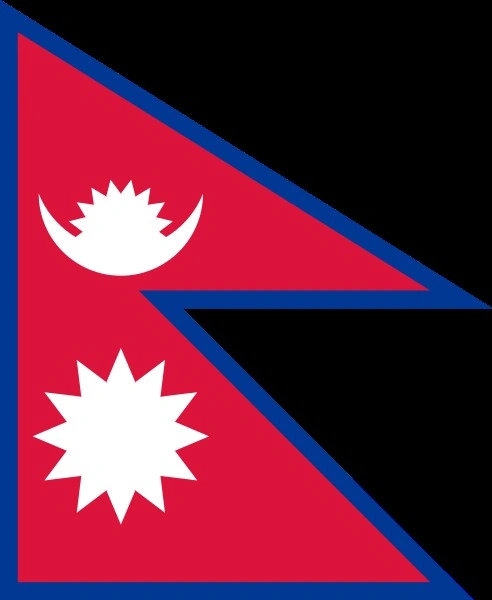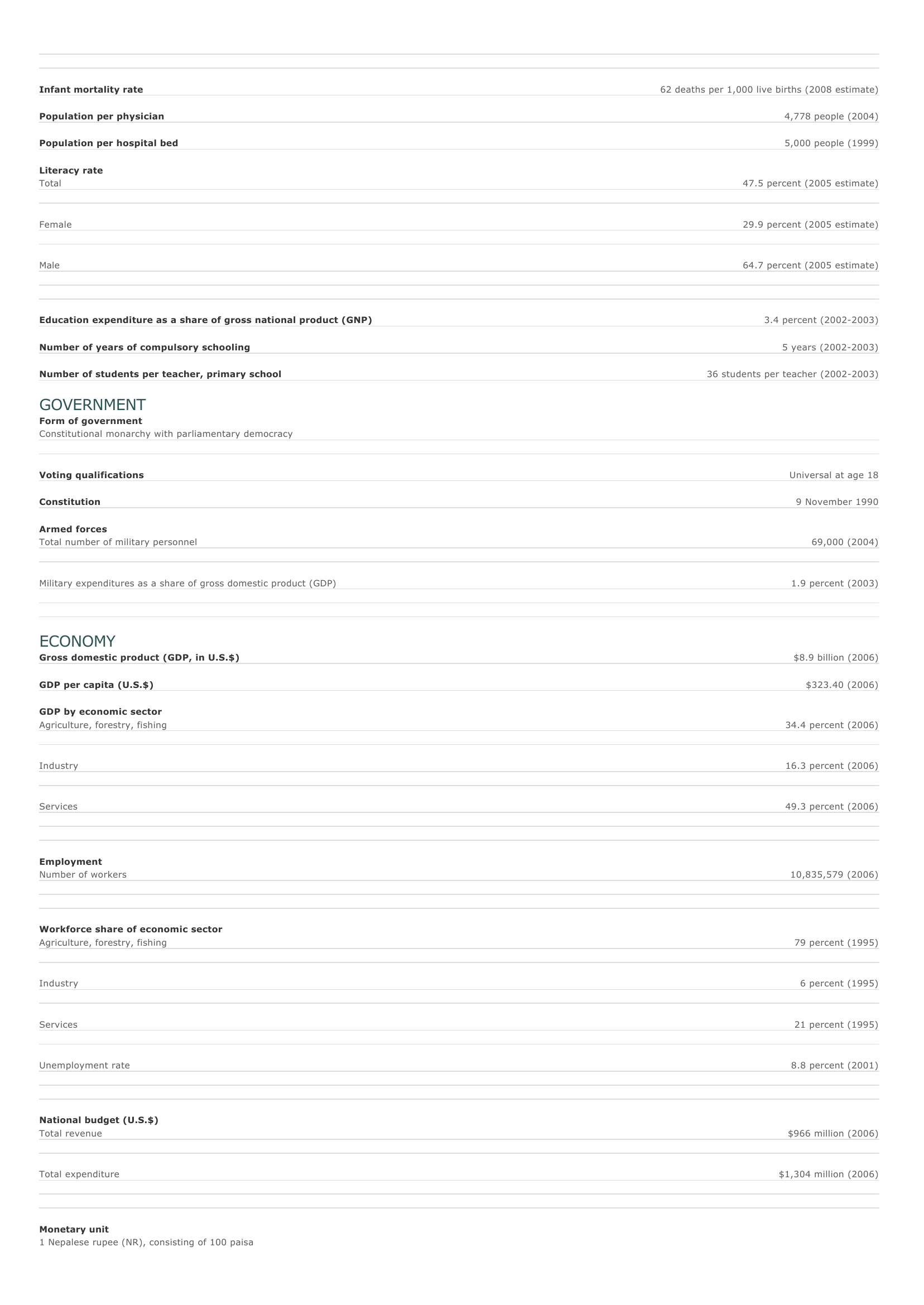
Nepal Facts and Figures. BASIC FACTS Official name Capital Area Kingdom of Nepal Kathmandu 147,181 sq km 56,827 sq mi PEOPLE Population 29,519,114 (2008 estimate) Population growth Population growth rate 2.10 percent (2008 estimate) Projected population in 2025 39,917,760 (2025 estimate) Projected population in 2050 53,293,874 (2050 estimate) Population density 206 persons per sq km (2008 estimate) 534 persons per sq mi (2008 estimate) Urban/rural distribution Share urban 16 percent (2005 estimate) Share rural 84 percent (2005 estimate) Largest cities, with population Kathmandu 741,000 (2003 estimate) Bir? tnagar 166,674 (2001 estimate) Lalitpur 162,991 (2001 estimate) P okhara 156,312 (2001 estimate) B ?rganj 112,484 (2001 estimate) Ethnic groups Newar, Bihari, Tibetan, Gurung, Magar, Tamang, Thakali, Bhutia, Rai, Limbu, Sherpa Languages Nepali (official), English, almost 20 other languages divided into numerous dialects Religious affiliations Hindu (Hinduism is the official religion) 86 percent Buddhist 8 percent Muslim 4 percent O ther 2 percent HEALTH AND EDUCATION Life expectancy Total 60.9 years (2008 estimate) Female 60.8 years (2008 estimate) Male 61.1 years (2008 estimate) Infant mortality rate 62 deaths per 1,000 live births (2008 estimate) Population per physician 4,778 people (2004) Population per hospital bed 5,000 people (1999) Literacy rate Total 47.5 percent (2005 estimate) Female 29.9 percent (2005 estimate) Male 64.7 percent (2005 estimate) Education expenditure as a share of gross national product (GNP) Number of years of compulsory schooling Number of students per teacher, primary school 3.4 percent (2002-2003) 5 years (2002-2003) 36 students per teacher (2002-2003) GOVERNMENT Form of government Constitutional monarchy with parliamentary democracy Voting qualifications Constitution Armed forces Total number of military personnel Military expenditures as a share of gross domestic product (GDP) Universal at age 18 9 November 1990 69,000 (2004) 1.9 percent (2003) ECONOMY Gross domestic product (GDP, in U.S.$) GDP per capita (U.S.$) $8.9 billion (2006) $323.40 (2006) GDP by economic sector Agriculture, forestry, fishing 34.4 percent (2006) I ndustry 16.3 percent (2006) Services 49.3 percent (2006) Employment Number of workers 10,835,579 (2006) Workforce share of economic sector Agriculture, forestry, fishing 79 percent (1995) I ndustry 6 percent (1995) Services 21 percent (1995) Unemployment rate 8.8 percent (2001) National budget (U.S.$) Total revenue Total expenditure Monetary unit 1 Nepalese rupee (NR), consisting of 100 paisa $966 million (2006) $1,304 million (2006) Major trade partners for exports India, United States, Germany, United Kingdom, and Canada Major trade partners for imports India, China, United Arab Emirates, Singapore, and Hong Kong SAR ENERGY, COMMUNICATIONS, AND TRANSPORTATION Electricity production Electricity from thermal sources 11.82 percent (2003 estimate) Electricity from hydroelectric sources 88.18 percent (2003 estimate) Electricity from nuclear sources 0 percent (2003 estimate) Electricity from geothermal, solar, and wind sources 0 percent (2003 estimate) Number of radios per 1,000 people 38 (1997) Number of telephones per 1,000 people 17 (2005) Number of televisions per 1,000 people 6.8 (2000 estimate) Number of Internet hosts per 10,000 people Daily newspaper circulation per 1,000 people Number of motor vehicles per 1,000 people Paved road as a share of total roads 0.39 (2003) 11 (1996) Not available 30 percent (2004) SOURCES Basic Facts and People sections Area data are from the statistical bureaus of individual countries. Population, population growth rate, and population projections are from the United States Census Bureau, International Programs Center, International Data Base (IDB) (www.census.gov). Urban and rural population data are from the Food and Agriculture Organization (FAO) of the United Nations (UN), FAOSTAT database (www.fao.org). Largest cities population data and political divisions data are from the statistical bureaus of individual countries. Ethnic divisions and religion data are largely from the latest Central Intelligence Agency (CIA) World Factbook and from various country censuses and reports. Language data are largely from the Ethnologue, Languages of the World, Summer Institute of Linguistics International (www.sil.org). Health and Education section Life expectancy and infant mortality data are from the United States Census Bureau, International Programs Center, International database (IDB) (www.census.gov). Population per physician and population per hospital bed data are from the World Health Organization (WHO) (www.who.int). Education data are from the United Nations Educational, Scientific and Cultural Organization (UNESCO) database (www.unesco.org). Government section Government, independence, legislature, constitution, highest court, and voting qualifications data are largely from various government Web sites, the latest Europa World Yearbook, and the latest Central Intelligence Agency (CIA) World Factbook. The armed forces data is from Military Balance. Economy section Gross domestic product (GDP), GDP per capita, GDP by economic sectors, employment, and national budget data are from the World Bank database (www.worldbank.org). Monetary unit, agriculture, mining, manufacturing, exports, imports, and major trade partner information is from the statistical bureaus of individual countries, latest Europa World Yearbook, and various United Nations and International Monetary Fund (IMF) publications. Energy, Communication, and Transportation section Electricity information is from the Energy Information Administration (EIA) database (www.eia.doe.gov). Radio, telephone, television, and newspaper information is from the United Nations Educational, Scientific and Cultural Organization (UNESCO) database (www.unesco.org). Internet hosts, motor vehicles, and road data are from the World Bank database (www.worldbank.org). Note Figures may not total 100 percent due to rounding. Microsoft ® Encarta ® 2009. © 1993-2008 Microsoft Corporation. All rights reserved.



































